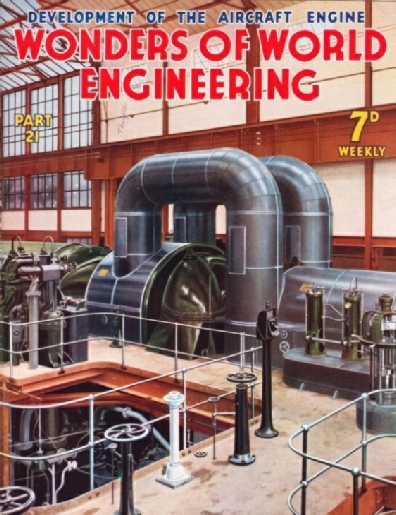

© Wonders of World Engineering 2014-




Part 21
Part 21 of Wonders of World Engineering was published on Tuesday 20th July 1937, price 7d.
Part 21 includes a colour plate showing An Aircraft Engine Being Tested at the Royal Aircraft Establishment. It formed part of the article on Aircraft Engines. The colour plate was previously used as the cover design for part 18.
The Cover
The cover of this week’s part shows the interior of the turbine house of the Metropolitan Borough of Hackney (London) Electricity Works. The subject is a 30,000-kilowatts turbine which was installed in 1932. At a speed of 3,0000 revolutions a minute, the turbine generates about 40,000 horse-power.
This cover illustration was later reproduced as the colour plate in Part 50.

Contents of Part 21
Conquest of the Severn (Part 2)
The story of the building of the Severn Tunnel, concluded from part 20. This is the fifth article in the series Below the Surface.
Manufacture of Glass
This chapter describes the various processes involved in the manufacture of glass. Glass-making has been carried out for more than three thousand years, and in Great Britain since the Roman occupation. The glass industry to-day affords one of the most interesting and spectacular displays that can be seen. Rivers of molten glass slowly change into streams of gleaming crystal and from tanks of the molten material great cylinders of shining glass rise majestically to as high as 50 feet above the ground. This is the fourth article in the series on the Romance of Industry.
Bridges in the Highlands
All over Scotland with its mountains and valleys and rivers, lakes and sea lochs, there are road and railway bridges of outstanding interest. This chapter describes many of the important bridges in the Scottish Highlands. General Wade, the great Thomas Telford and Rennie in the eighteenth and early nineteenth centuries were responsible for many bridges which are still in use to-day. Of the more recent structures the Glenfinnan Viaduct and the Connel Ferry Bridge are outstanding examples of how the engineers have been able to span waterways and valleys to carry the railway and the road through mountain fastnesses. This is the eighth article in the series Linking the World’s Highways.
A Lift for 1,000-Tons Barges
German engineers in 1934 completed a unique feat of engineering when the Niederfinow Barge Lift, on the Hohenzollern Canal, raised for the first time barges weighing 1,000 tons a vertical distance of 116 feet. This famous barge lift on the Hohenzollern Canal is described in this chapter. Work started on the scheme in 1926, and eight years later the Niederfinow Barge Lift was opened. The lift, it was estimated, would weigh more than 20,000 tons, and to take this weight the engineers were faced with building extremely solid and immovable foundations.
Agricultural Tractor
Since the coming of the petrol engine the plough, the harrow or the harvesting machine is attached directly to a tractor which has the same degree of mobility as the horse. The tractor described in this chapter will do the work of eight to twelve horses, according to the nature of the ground, the “rated” drawbar pull being 13.5 horse-power. This is the twelfth article in the series on Modern Engineering Practice.
Aircraft Engines
Developed from the motor car engine of thirty years ago, the aircraft engine of to-day is a miracle of efficiency and compactness. For high-powered engines the water-cooled “V” type is rivalled by the air-cooled radial type; for smaller engines the air-cooled “in line” arrangement is popular. This chapter describes the evolution of the aircraft engine over more than thirty years.
An Aircraft Engine Being Tested (colour plate)
